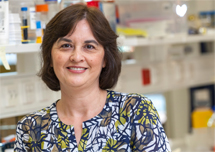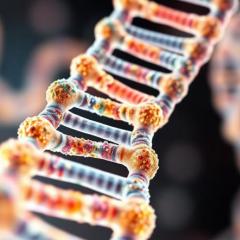
by Dr Fiona McMillan
University of Queensland Diamantina Institute researcher Dr Liliana Endo Munoz has discovered that the cells responsible for normal bone destruction may help prevent bone cancer from spreading.
Moreover, her search for genetic differences between tumours that spread and those that don’t is revealing new therapeutic targets and identifying disease ‘markers’ that could enable life-saving early detection.
Osteosarcoma (OS) can strike at any age, but arises most often in teenagers. It is the most common childhood bone cancer and the third most common cancer in adolescence, following lymphomas and brain cancers.
800 new patients are diagnosed with OS every year in the US — half of whom are under the age of 20 — and the disease follows a similar incidence rate worldwide.
No early diagnostics exist for OS; pain is often the first symptom. Unfortunately, because the disease often presents at an age associated with growth spurts and high levels of physical activity, symptoms can be mistaken for growing pains or sports injuries. Sometimes, though, the first sign is a bone that breaks with little or no impact.
Prognosis hinges on whether or not the cancer has already spread to other tissues via a process called metastasis. OS metastases have a preference for lung tissue, and at the time of diagnosis, up to 80% of patients already have very small ‘micro’-metastases in their lungs. Ultimately, half of all OS patients develop metastatic OS, which is associated with poor survival.
"Lung metastases only marginally respond to chemotherapy and no one knows why,” explains Dr Endo Munoz. “Current treatments haven’t changed in 30 years. We need to improve what we’re doing.”
That the disease follows such different trajectories in different patients hints at its underlying complexity. But in that complexity, Dr Endo Munoz sees the potential for answers.
Bone is actually quite a dynamic organ. In addition to rigid, calcified structures, bone contains blood vessels, collagen, and a variety of cell types responsible for bone growth and re-absorption. Bone function, growth and repair are dependent on a delicate balance between osteoblasts (bone forming cells) and osteoclasts (bone destroying cells). Although osteoclasts may sound destructive, they have many important functions. They release stored minerals and growth factors, they guide stem cells from the bone marrow into the blood stream and they can participate in immune responses.
Dr Endo Munoz, who is based at the Translational Research Institute, analysed the cellular makeup of primary OS tumours and discovered that metastatic tumours were the only kind that did not contain osteoclasts. She is now investigating whether osteoclasts send signals that prevent metastasis and whether metastatic tumours, in turn, find ways to shut down osteoclast growth in order to get around this roadblock.
Her work has also revealed that not all cells within a metastatic tumour have the same capacity to spread. She is now comparing the genomes of tumour cells that spread with the genomes of those that don’t in order to identify which genes drive metastasis. Already she has identified two candidates, one of which is the target of an existing therapeutic compound. When she tested the drug on mice with OS, it significantly reduced metastasis. Pre-clinical studies are now underway with a view to human trials in the near future.
Dr Endo Munoz has now expanded her search to compare everything she can: genomes, proteins, RNA and more. The aim of this exhaustive screen is to find bone cancer ‘markers’ for use in early diagnostics and to identify new therapeutic targets. The search has recently revealed a protein that appears to be overabundant in metastatic OS. When Dr Endo Munoz disrupted the protein’s activity, she saw a significant decrease in tumour spreading.
“We are also investigating how circulating OS tumour cells travel from the bone to the lung,” she adds, “including what changes take place in the lung that attract OS cells and allow OS cells to establish and form tumours once they get there.”
This work may help explain why metastasis happens rapidly in some patients but not in others, and whether there is something unique about lung tissue that attracts spreading cancers.
When asked what keeps her going, she replies, “It’s a cancer that affects children and teens. When we look at the years lost, it’s very tragic.”
But she is optimistic about the direction of her research. "When we started we had no targets. Now we have four. The clinical trials with the new therapeutic compounds offer great promise for future trials in human patients.”



